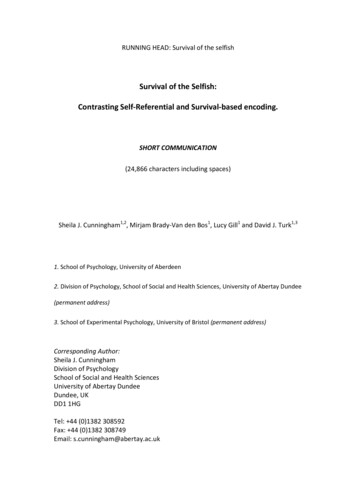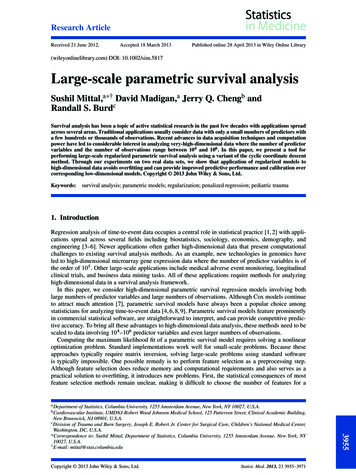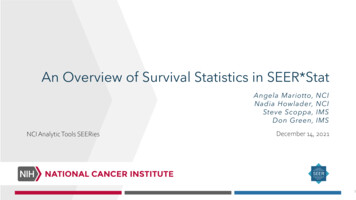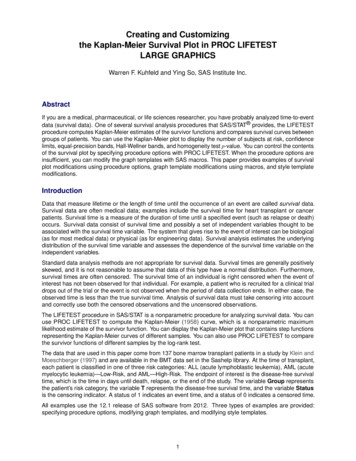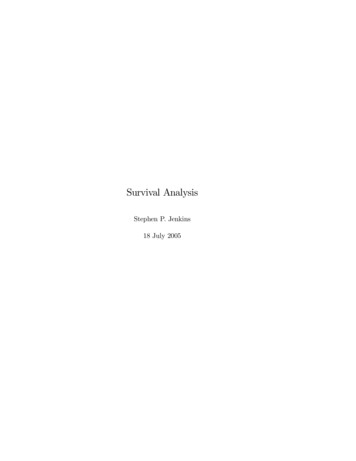
Transcription
Survival AnalysisStephen P. Jenkins18 July 2005
ii
ContentsPrefacexi1 Introduction1.11.21.31.41What survival analysis is about . . . . . . . . . . . . . . . . . . .1Survival time data: some notable features . . . . . . . . . . . . .31.2.1 Censoring and truncation of survival time data . . . . . .41.2.2 Continuous versus discrete (or grouped) survival time data 61.2.3 Types of explanatory variables . . . . . . . . . . . . . . .7Why are distinctive statistical methods used? . . . . . . . . . . .81.3.1 Problems for OLS caused by right censoring . . . . . . . .81.3.2 Time-varying covariates and OLS . . . . . . . . . . . . . .91.3.3 ‘Structural’modelling and OLS . . . . . . . . . . . . . . .91.3.4 Why not use binary dependent variable models ratherthan OLS? . . . . . . . . . . . . . . . . . . . . . . . . . .9Outline of the book . . . . . . . . . . . . . . . . . . . . . . . . . . 102 Basic concepts: the hazard rate and survivor function2.12.22.3Continuous time . . . . . . . . . . . . . . . . . . . . . . . . . . .2.1.1 The hazard rate . . . . . . . . . . . . . . . . . . . . . . .2.1.2 Key relationships between hazard and survivor functions .Discrete time . . . . . . . . . . . . . . . . . . . . . . . . . . . . .2.2.1 Survival in continuous time but spell lengths are intervalcensored . . . . . . . . . . . . . . . . . . . . . . . . . . . .2.2.2 The discrete time hazard when time is intrinsically discrete2.2.3 The link between the continuous time and discrete timecases . . . . . . . . . . . . . . . . . . . . . . . . . . . . . .Choosing a speci cation for the hazard rate . . . . . . . . . . . .2.3.1 Continuous or discrete survival time data? . . . . . . . . .2.3.2 The relationship between the hazard and survival time . .2.3.3 What guidance from economics? . . . . . . . . . . . . . .iii131314151617192021212222
ivCONTENTS3 Functional forms for the hazard rate253.1Introduction and overview: a taxonomy . . . . . . . . . . . . . .253.2Continuous time speci cations . . . . . . . . . . . . . . . . . . .3.2.1 Weibull model and Exponential model . . . . . . . . . . .3.2.2 Gompertz model . . . . . . . . . . . . . . . . . . . . . . .3.2.3 Log-logistic Model . . . . . . . . . . . . . . . . . . . . . .3.2.4 Lognormal model . . . . . . . . . . . . . . . . . . . . . . .3.2.5 Generalised Gamma model . . . . . . . . . . . . . . . . .3.2.6 Proportional Hazards (PH) models . . . . . . . . . . . . .3.2.7 Accelerated Failure Time (AFT) models . . . . . . . . . .3.2.8 Summary: PH versus AFT assumptions for continuoustime models . . . . . . . . . . . . . . . . . . . . . . . . . .3.2.9 A semi-parametric speci cation: the piecewise-constantExponential (PCE) model . . . . . . . . . . . . . . . . . .Discrete time speci cations . . . . . . . . . . . . . . . . . . . . .26262727282828333.33838403.3.13.4A discrete time representation of a continuous time proportional hazards model . . . . . . . . . . . . . . . . . . .3.3.2 A model in which time is intrinsically discrete . . . . . . .3.3.3 Functional forms for characterizing duration dependencein discrete time models . . . . . . . . . . . . . . . . . . .Deriving information about survival time distributions . . . . . .3.4.1 The Weibull model . . . . . . . . . . . . . . . . . . . . . .3.4.2 Gompertz model . . . . . . . . . . . . . . . . . . . . . . .3.4.3 Log-logistic model . . . . . . . . . . . . . . . . . . . . . .3.4.4 Other continuous time models . . . . . . . . . . . . . . . .4445455050533.4.553Discrete time models . . . . . . . . . . . . . . . . . . . . .4 Estimation of the survivor and hazard functions4.14.2Kaplan-Meier (product-limit) estimators . . . . . . . . . . . . . .4.1.1 Empirical survivor function . . . . . . . . . . . . . . . . .Lifetable estimators . . . . . . . . . . . . . . . . . . . . . . . . .5 Continuous time multivariate models5.0.15.0.25.0.35.0.4Random sample of in‡ow and each spell monitored untilcompleted . . . . . . . . . . . . . . . . . . . . . . . . . . .Random sample of in‡ow with (right) censoring, monitored until t . . . . . . . . . . . . . . . . . . . . . . . . .Random sample of population, right censoring but censoring point varies . . . . . . . . . . . . . . . . . . . . . .Left truncated spell data (delayed entry) . . . . . . . . . .4143555556586162636364
CONTENTS5.15.0.5 Sample from stock with no re-interview . . . . .5.0.6 Right truncated spell data (out‡ow sample) . . .Episode splitting: time-varying covariates and estimationtinuous time models . . . . . . . . . . . . . . . . . . . .v. . . . . . . . .of con. . . . .6 Discrete time multivariate models6.16.26.366676871In‡ow sample with right censoring . . . . . . . . . . . . . . . . .Left-truncated spell data (‘delayed entry’) . . . . . . . . . . . . .Right-truncated spell data (out‡ow sample) . . . . . . . . . . . .7173757 Cox’s proportional hazard model778 Unobserved heterogeneity (‘frailty’)818.18.28.3Continuous time case . . . . . . . . . . . . . . . . . . . . . . .Discrete time case . . . . . . . . . . . . . . . . . . . . . . . .What if unobserved heterogeneity is ‘important’but ignored?8.3.1 The duration dependence e ect . . . . . . . . . . . . .82848687The proportionate response of the hazard to variations ina characteristic . . . . . . . . . . . . . . . . . . . . . . . .Empirical practice . . . . . . . . . . . . . . . . . . . . . . . . . .87898.3.28.49 Competing risks models9.19.29.39.49.591Continuous time data . . . . . . . . . . . . . . . . . . . . . . . . 91Intrinsically discrete time data . . . . . . . . . . . . . . . . . . . 93Interval-censored data . . . . . . . . . . . . . . . . . . . . . . . . 979.3.1 Transitions can only occur at the boundaries of the intervals. 999.3.2 Destination-speci c densities are constant within intervals 1019.3.3 Destination-speci c hazard rates are constant within intervals . . . . . . . . . . . . . . . . . . . . . . . . . . . . . 1039.3.4 Destination-speci c proportional hazards with a commonbaseline hazard function . . . . . . . . . . . . . . . . . . . 1069.3.5 The log of the integrated hazard changes at a constantrate over the interval . . . . . . . . . . . . . . . . . . . . . 108Extensions . . . . . . . . . . . . . . . . . . . . . . . . . . . . . . . 1089.4.1 Left-truncated data . . . . . . . . . . . . . . . . . . . . . 1089.4.2 Correlated risks . . . . . . . . . . . . . . . . . . . . . . . . 109Conclusions and additional issues . . . . . . . . . . . . . . . . . . 11010 Additional topics113References115
viAppendixCONTENTS121
List of Tables1.1Examples of life-course domains and states . . . . . . . . . . . .23.13.23.326343.43.5Functional forms for the hazard rate: examples . . . . . . . . . .Di erent error term distributions imply di erent AFT models . .Speci cation summary: proportional hazard versus acceleratedfailure time models . . . . . . . . . . . . . . . . . . . . . . . . . .Classi cation of models as PH or AFT: summary . . . . . . . . .Ratio of mean to median survival time: Weibull model . . . . . .4.1Example of data structure . . . . . . . . . . . . . . . . . . . . . .565.1Example of episode splitting . . . . . . . . . . . . . . . . . . . . .696.1Person and person-period data structures: example . . . . . . . .737.1Data structure for Cox model: example . . . . . . . . . . . . . .78vii383849
viiiLIST OF TABLES
List of Figuresix
xLIST OF FIGURES
PrefaceThese notes were written to accompany my Survival Analysis module in themasters-level University of Essex lecture course EC968, and my Essex UniversitySummer School course on Survival Analysis.1 (The rst draft was completedin January 2002, and has been revised several times since.) The course readinglist, and a sequence of lessons on how to do Survival Analysis (based aroundthe Stata software package), are downloadable ephenj/ec968/index.php.Please send me comments and suggestions on both these notes and the doit-yourself lessons:Email: stephenj@essex.ac.ukPost: Institute for Social and Economic Research, University of Essex, Wivenhoe Park, Colchester CO4 3SQ, United Kingdom.Beware: the notes remain work in progress, and will evolve as and when timeallows. Charts and graphs from the classroom presentations are not included(you have to get something for being present in person!). The document wasproduced using Scienti c Workplace version 5.0 (formatted using the ‘StandardLaTeX book’style).My lectures were originally based on a set of overhead transparencies givento me by John Micklewright (University of Southampton) that he had used ina graduate microeconometrics lecture course at the European University Institute. Over the years, I have also learnt much about survival analysis fromMark Stewart (University of Warwick) and John Ermisch (University of Essex).Robert Wright (University of Stirling) patiently answered questions when I rststarted to use survival analysis. The Stata Reference Manuals written by theStataCorp sta have also been a big in‡uence. They are superb, and useful asa text not only as program manuals. I have also drawn inspiration from otherStata users. In addition to the StataCorp sta , I would speci cally like to cite1 Information about Essex Summer School courses and how to apply is available fromhttp://www.essex.ac.uk/methods.xi
xiiPREFACEthe contributions of Jeroen Weesie (Utrecht University) and Nick Cox (DurhamUniversity). The writing of Paul Allison (University of Pennsylvania) on survival analysis has also in‡uenced me, providing an exemplary model of how toexplain complex issues in a clear non-technical manner.I wish to thank Janice Webb for word-processing a preliminary draft of thenotes. I am grateful to those who have drawn various typographic errors tomy attention, and also made several other helpful comments and suggestions. Iwould like to especially mention Paola De Agostini, José Diaz, Annette Jäckle,Lucinda Platt, Thomas Siedler and the course participants at Essex and elsewhere (including Frigiliana, Milan, and Wellington).The responsibility for the content of these notes (and the web-based) Lessonsis mine alone.If you wish to cite this document, please refer to:Jenkins, Stephen P. (2004). Survival Analysis. Unpublished manuscript, Institute for Social and Economic Research, University of Essex, Colchester, UK.Downloadable from nj/ec968/pdfs/ec968lnotesv6.pdc Stephen P. Jenkins, 2005.
Chapter 1Introduction1.1What survival analysis is aboutThis course is about the modelling of time-to-event data, otherwise known astransition data (or survival time data or duration data). We consider a particular life-course ‘domain’, which may be partitioned into a number of mutuallyexclusive states at each point in time. With the passage of time, individualsmove (or do not move) between these states. For some examples of life-coursedomains and states, see Table 1.1.For each given domain, the patterns for each individual are described by thetime spent within each state, and the dates of each transition made (if any).Figure 1, from Tuma and Hannan (1984, Figure 3.1) shows a hypothetical marital history for an individual. There are three states (married, not married,dead) di erentiated on the vertical axis, and the horizontal axis shows the passage of time t. The length of each horizontal line shows the time spent withineach state, i.e. spell lengths, or spell durations, or survival times. More generally, we could imagine having this sort of data for a large number of individuals(or rms or other analytical units), together with information that describesthe characteristics of these individuals (to be used as explanatory variables inmultivariate models).This course is about the methods used to model transition data, and therelationship between transition patterns and characteristics. Data patterns ofthe sort shown in Figure 1 are quite complex however; in particular, there aremulti-state transitions (three states) and repeat spells within a given state (twospells in the state ‘not-married’). Hence, to simplify matters, we shall focus onmodels to describe survival times within a single state, and assume that we havesingle spell data for each individual. Thus, for the most part, we consider exitsfrom a single state to a single destination.11 Nonetheless we shall, later, allow for transitions to multiple destination states underthe heading ‘independent competing risk’ models, and shall note the conditions under whichrepeated spell data may be modelled using single-spell methods.1
2CHAPTER 1. INTRODUCTIONDomainMarriageReceipt of cash bene tHousing tenurePaid eceiving bene t xreceiving bene t yreceiving x and yreceiving neitherowned-outrightowned with mortgagerenter –social housingrenter tiveretiredTable 1.1: Examples of life-course domains and statesWe also make a number of additional simplifying assumptions:the chances of making a transition from the current state do not dependon transition history prior to entry to the current state (there is no statedependence);entry into the state being modelled is exogenous – there are no ‘initialconditions’problems. Otherwise the models of survival times in the currentstate would also have to take account of the di erential chances of beingfound in the current state in the rst place;the model parameters describing the transition process are xed, or canbe parameterized using explanatory variables –the process is stationary.The models that have been specially developed or adapted to analyze survivaltimes are distinctive largely because they need to take into account some specialfeatures of the data, both the ‘dependent’ variable for analysis (survival timeitself), and also the explanatory variables used in our multivariate models. Letus consider these features in turn.
1.2. SURVIVAL TIME DATA: SOME NOTABLE FEATURES1.23Survival time data: some notable featuresSurvival time data may be derived in a number of di erent ways, and the waythe data are generated has important implications for analysis. There are fourmain types of sampling process providing survival time data:1. Stock sample Data collection is based upon a random sample of the individuals that are currently in the state of interest, who are typically (butnot always) interviewed at some time later, and one also determines whenthey entered the state (the spell start date). For example, when modelling the length of spells of unemployment insurance (UI) receipt, onemight sample all the individuals who were in receipt of UI at a given date,and also nd out when they rst received UI (and other characteristics).2. In‡ow sample Data collection is based on a random sample of all personsentering the state of interest, and individuals are followed until some prespeci ed date (which might be common to all individuals), or until thespell ends. For example, when modelling the length of spells of receipt ofunemployment insurance (UI), one might sample all the individuals whobegan a UI spell.3. Out‡ow sample Data collection is based on a random sample of thoseleaving the state of interest, and one also determines when the spell began.For example, to continue our UI example, the sample would consist ofindividuals leaving UI recept.4. Population sample Data collection is based on a general survey of thepopulation (i.e. where sampling is not related to the process of interest),and respondents are asked about their current and/or previous spells ofthe type of interest (starting and ending dates).Data may also be generated from combinations of these sample types. Forexample, the researcher may build a sample of spells by considering all spellsthat occurred between two dates, for example between 1 January and 1 Juneof a given year. Some spells will already be in progress at the beginning ofthe observation window (as in the stock sample case), whereas some will beginduring the window (as in the in‡ow sample case).The longitudinal data in these four types of sample may be collected fromthree main types of survey or database:1. Administrative records For example, information about UI spells may bederived from the database used by the government to administer the bene t system. The administrative records may be the sole source of information about the individuals, or may be combined with a social surveythat asks further questions of the persons of interest.2. Cross-section sample survey, with retrospective questions In this case, respondents to a survey are asked to provide information about their spells
4CHAPTER 1. INTRODUCTIONin the state of interest using retrospective recall methods. For example,when considering how long marriages last, analysts may use questions asking respondents whether they are currently married, or ever have been,and determining the dates of marriage and of divorce, separation, andwidowhood. Similar sorts of methods are commonly used to collect information about personal histories of employment and jobs over the workinglife.3. Panel and cohort surveys, with prospective data collection In this case, thelongitudinal information is built from repeated interviews (or other sortsof observation) on the sample of interest at a number of di erent pointsin time. At each interview, respondents are typically asked about theircurrent status, and changes since the previous interview, and associateddates.Combinations of these survey instruments may be used. For example a panelsurvey may also include retrospective question modules to ask about respondents’experiences before the survey began. Administrative records containinglongitudinal data may be matched into a sample survey, and so on.The main lesson of this brief introduction to data collection methods isthat, although each method provides spell data, the nature of the informationabout the spells di ers, and this has important implications for how one shouldanalyze the data. The rest of this section highlight the nature of the di erencesin information about spells. The rst aspect concerns whether survival timesare complete, censored or truncated. The second and related aspect concernswhether the analyst observes the precise dates at which spells are observed (orelse survival times are only observed in intervals of time, i.e. grouped or banded)or, equivalently – at least from the analytic point of view – whether survivaltimes are intrinsically discrete.1.2.1Censoring and truncation of survival time dataA survival time is censored if all that is known is that it began or ended withinsome particular interval of time, and thus the total spell length (from entry timeuntil transition) is not known exactly. We may distinguish the following typesof censoring:Right censoring: at the time of observation, the relevant event (transitionout of the current state) had not yet occurred (the spell end date is unknown), and so the total length of time between entry to and exit fromthe state is unknown. Given entry at time 0 and observation at time t, weonly know that the completed spell is of length T t.Left censoring: the case when the start date of the spell was not observed,so again the exact length of the spell (whether completed or incomplete)is not known. Note that this is the de nition of left censoring most commonly used by social scientists. (Be aware that biostatisticians typically
1.2. SURVIVAL TIME DATA: SOME NOTABLE FEATURES5use a di erent de nition: to them, left-censored data are those for whichit is known that exit from the state occurred at some time before theobservation date, but it is not known exactly when. See e.g. Klein andMoeschberger, 1997.)By contrast, truncated survival time data are those for which there is asystematic exclusion of survival times from one’s sample, and the sample selection e ect depends on survival time itself. We may distinguish two types oftruncation:Left truncation: the case when only those who have survived more thansome minimum amount of time are included in the observation sample(‘small’ survival times – those below the threshold – are not observed).Left truncation is also known by other names: delayed entry and stocksampling with follow-up. The latter term is the most-commonly referredto by economists, re‡ecting the fact that data they use are often generatedin this way. If one samples from the stock of persons in the relevant stateat some time s, and interviews them some time later, then persons withshort spells are systematically excluded. (Of all those who began a spellat time r s, only those with relatively long spells survived long enoughto be found in the stock at time s and thence available to be sampled.)Note that the spell start is assumed known in this case (cf. left censoring),but the subject’s survival is only observed from some later date – hence‘delayed entry’.Right truncation: this is the case when only those persons who have experienced the exit event by some particular date are included in the sample,and so relatively ‘long’survival times are systematically excluded. Righttruncation occurs, for example, when a sample is drawn from the personswho exit from the state at a particular date (e.g. an out‡ow sample fromthe unemployment register).The most commonly available survival time data sets contain a combinationof survival times in which either (i) both entry and exit dates are observed(completed spell data), or (ii) entry dates are observed and exit dates are notobserved exactly (right censored incomplete spell data). The ubiquity of suchright censored data has meant that the term ‘censoring’is often used as a shorthand description to refer to this case. We shall do so as well.See Figure 2 for some examples of di erent types of spells. *** insert andadd comments ***We assume that the process that gives rise to censoring of survival times isindependent of the survival time process. There is some latent failure time forperson i given by Ti and some latent censoring time Ci , and what we observe isTi minfTi ; Ci g. See the texts for more about the di erent types of censoringmechanisms that have been distinguished in the literature. If right-censoring isnot independent –instead its determinants are correlated with the determinantsof the transition process – then we need to model the two processes jointly.
6CHAPTER 1. INTRODUCTIONAn example is where censoring arises through non-random sample drop-out(‘attrition’).1.2.2Continuous versus discrete (or grouped) survival timedataSo far we have implicitly assumed that the transition event of interest may occurat any particular instant in time; the stochastic process occurs in continuoustime. Time is a continuum and, in principle, the length of an observed spelllength can be measured using a non-negative real number (which may be fractional). Often this is derived from observations on spell start dates and eitherspell exit dates (complete spells) or last observation date (censored spells). Survival time data do not always come in this form, however, and for two reasons.The rst reason is that survival times have been grouped or banded intodiscrete intervals of time (e.g. numbers of months or years). In this case, spelllengths may be summarised using the set of positive integers (1, 2, 3, 4, and soon), and the observations on the transition process are summarized discretelyrather than continuously. That is, although the underlying transition processmay occur in continuous time, the data are not observed (or not provided) inthat form. Biostatisticians typically refer to this situation as one of intervalcensoring, a natural description given the de nitions used in the previous subsection. The occurence of tied survival times may be an indicator of intervalcensoring. Some continuous time models often (implicitly) assume that transitions can only occur at di erent times (at di erent instants along the timecontinuum), and so if there is a number of individuals in one’s data set withthe same survival time, one might ask whether the ties are genuine, or simplybecause survival times have been grouped at the observation or reporting stage.The second reason for discrete time data is when the underlying transitionprocess is an intrinsically discrete one. Consider, for example, a machine toolset up to carry out a speci c cycle of tasks and this cycle takes a xed amountof time. When modelling how long it takes for the machine to break down, itwould be natural to model failure times in terms of the number of discrete cyclesthat the machine tool was in operation. Similarly when modelling fertility, andin particular the time from puberty to rst birth, it might be more natural tomeasure time in terms of numbers of menstrual cycles rather than number ofcalendar months.Since the same sorts of models can be applied to discrete time data regardlessof the reason they were generated (as we shall see below), we shall mostly refersimply to discrete time models, and constrast these with continuous time models.Thus the more important distinction is between discrete time data and continuous time data. Models for the latter are the most commonly available andmost commonly applied, perhaps re‡ecting their origins in the bio-medical sciences. However discrete time data are relatively common in the social sciences.One of the themes of this lecture course is that one should use models thatre‡ect the nature of the data available. For this reason, more attention is givento discrete time models than is typically common. For the same reason, I give
1.2. SURVIVAL TIME DATA: SOME NOTABLE FEATURES7more explicit attention to how to estimate models using data sets containingleft-truncated spells than do most texts.1.2.3Types of explanatory variablesThere are two main types. Contrast, rst, explanatory variables that describethe characteristics of the observation unit itself (e.g. a person’s age, or a rm’s size), versusthe characteristics of the socio-economic environment of the observationunit (e.g. the unemployment rate of the area in which the person lives).As far model speci cation is concerned, this distinction makes no di erence.It may make a signi cant di erence in practice, however, as the rst type ofvariables are often directly available in the survey itself, whereas the secondtype often have to be collected separately and then matched in.The second contrast is between explanatory variables that are xed over time, whether time refers to calendar time or survival timewithin the current state, e.g. a person’s sex; andtime-varying, and distinguish between those that vary with survival timeand those vary with calendar time.The unemployment rate in the area in which a person lives may vary withcalendar time (the business cycle), and this can induce a relationship with survival time but does not depend intrinsically on survival time itself. By contrast,social assistance bene t rates in Britain used to vary with the length of timethat bene t had been received: Supplementary Bene t was paid at the shortterm rate for spells up to 12 months long, and paid at a (higher) long-term ratefor the 13th and subsequent months for spells lasting this long. (In additionsome calendar time variation in the bene t generosity in real terms was inducedby in‡ation, and by annual uprating of bene t amounts at the beginning of each nancial year (April).)Some books refer to time-dependent variables. These are either the same asthe time-varying variables described above or, sometimes, variables for whichchanges over time can be written directly as a function of survival time. Forexample, given some personal characteristic summarized using variable X, andsurvival time t, such a time-dependent variable might be X log(t).The distinction between xed and time-varying covariates is relevant forboth analytical and practical reasons. Having all explanatory variables xedmeans that analytical methods and empirical estimation are more straightforward. With time-varying covariates, some model interpretations no longer hold.And from a practical point of view, one has to re-organise one’s data set in orderto incorporate them and estimate models. More about this ‘episode splitting’later on.
8CHAPTER 1. INTRODUCTION1.3Why are distinctive statistical methods used?This section provides some motivation for the distinctive specialist methodsthat have been developed for survival analysis by considering why some of themethods that are commonly used elsewhere in economics and other quantitativesocial science disciplines cannot be applied in this context (at least in theirstandard form). More speci cally, what is the problem with using either (1)Ordinary Least Squares (OLS) regressions of survival times, or with using (2)binary dependent variable regression models (e.g. logit, probit) with transitionevent occurrence as the dependent variable? Let us consider these in turn.OLS cannot handle three aspects of survival time data very well:censoring (and truncation)time-varying covariates‘structural’modelling1.3.1Problems for OLS caused by right censoringTo illustrate the (right) censoring issue, let us suppose that the ‘true’ modelis such that there is a single explanatory variable, Xi for each individual i 1; : : : ; n, who has a true survival time of Ti . In addition, in the population, ahigher X is associated with a shorter survival time. In the sample, we observeTi where Ti Ti for observations with completed spells, and Ti Ti for rightcensored observations.Suppose too that the incidence of censoring is higher at longer survival timesrelative to shorter survival times. (This does not necessarily con‡ict with theassumption of independence of the censoring and survival processes –it simplyre‡ects the passage of time. The longer the observation period, the greater theproportion of spells for which events are observed.)**CHART TO INSERT**Data ‘cloud’: combinations of
These notes were written to accompany my Survival Analysis module in the masters-level University of Essex lecture course EC968, and my Essex University Summer School course on Survival Analysis.1 (The -rst draft was completed in January 2002, and has been revised several times since.) The course reading
![[ST] Survival Analysis - Stata](/img/33/st.jpg)
